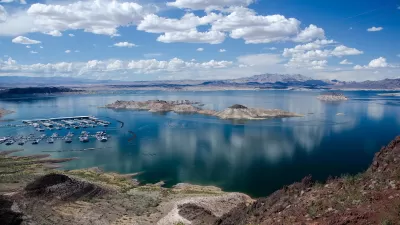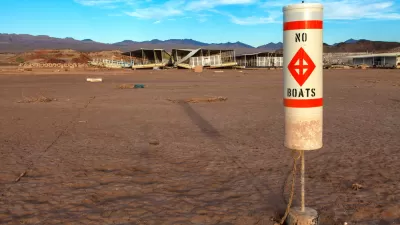State officials claim a proposal agreed upon by the other six states using Colorado River water disproportionately impacts California farmers.

Reporting for the Los Angeles Times, Ian James outlines California’s alternate proposal for managing the Colorado River’s dwindling water resources. “The state put forward its proposal a day after Arizona, Colorado, Nevada, New Mexico, Utah and Wyoming released their alternative.”
California officials claim the state’s “high-priority senior water rights dating back more than a century” must be protected under any new agreement. According to California’s natural resources secretary Wade Crowfoot, “The six-state proposal directly and disproportionately impacts California.” Much of the Colorado River’s Southern California allocations go to the region’s vast farmlands. Per the six-state plan, “A large portion of the cuts they proposed would be made by accounting for evaporation and other water losses along the lower portion of the river — a calculation that would translate into especially large reductions for California, which uses more Colorado River water than any other state.”
As James explains, “The state’s proposal builds on a previous commitment by four Southern California water agencies to cut water use by 400,000 acre-feet per year, a reduction of about 9%, through 2026. The federal government has asked the states to reduce their total usage by 2 to 4 million acre-feet.” California officials call the proposal “a realistic and implementable framework to address reduced inflows and declining reservoir elevations by building on voluntary agreements and past collaborative efforts in order to minimize the risk of legal challenge or implementation delay.” As the states continue to debate, federal officials plan to finalize an agreement this summer.
FULL STORY: California offers proposal on Colorado River crisis, disagreeing with six states

Alabama: Trump Terminates Settlements for Black Communities Harmed By Raw Sewage
Trump deemed the landmark civil rights agreement “illegal DEI and environmental justice policy.”

Study: Maui’s Plan to Convert Vacation Rentals to Long-Term Housing Could Cause Nearly $1 Billion Economic Loss
The plan would reduce visitor accommodation by 25% resulting in 1,900 jobs lost.

Why Should We Subsidize Public Transportation?
Many public transit agencies face financial stress due to rising costs, declining fare revenue, and declining subsidies. Transit advocates must provide a strong business case for increasing public transit funding.

Paris Bike Boom Leads to Steep Drop in Air Pollution
The French city’s air quality has improved dramatically in the past 20 years, coinciding with a growth in cycling.

Why Housing Costs More to Build in California Than in Texas
Hard costs like labor and materials combined with ‘soft’ costs such as permitting make building in the San Francisco Bay Area almost three times as costly as in Texas cities.

San Diego County Sees a Rise in Urban Coyotes
San Diego County experiences a rise in urban coyotes, as sightings become prevalent throughout its urban neighbourhoods and surrounding areas.
Urban Design for Planners 1: Software Tools
This six-course series explores essential urban design concepts using open source software and equips planners with the tools they need to participate fully in the urban design process.
Planning for Universal Design
Learn the tools for implementing Universal Design in planning regulations.
Smith Gee Studio
Alamo Area Metropolitan Planning Organization
City of Santa Clarita
Institute for Housing and Urban Development Studies (IHS)
City of Grandview
Harvard GSD Executive Education
Toledo-Lucas County Plan Commissions
Salt Lake City
NYU Wagner Graduate School of Public Service





























